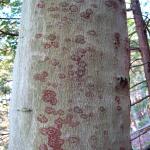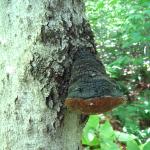Beech Bark Disease
Pathogen
In North America, beech bark disease (BBD) is a disease-insect complex that involves both non-native (Cryptococcus fagisuga) and native (Xylococculus betulae) scale insects and two species of the fungal pathogen Neonectria (N. ditissima and N. faginata) (Houston 1994, Castlebury et al. 2006). An additional Neonectria species (N. coccinea) is also involved but is known only from Europe (Castlebury et al. 2006, Hirooka et al. 2013). BBD has killed millions of American beech (Fagus grandifolia) throughout New England and has drastically altered the northern hardwood forest type, of which beech is a primary species (Houston 1994).
Hosts
American beech is the primary host of BBD in both forests and managed landscapes. In New England, European beech (F. sylvatica) is susceptible to infection but exhibits resistance in most settings, only rarely suffering severe cases of the disease. Neonectria ditissima has a broad host range among deciduous hardwoods and is also responsible for target canker of birch (Betula spp.).
Symptoms & Signs
The scale insects predispose American beech by using their piercing and sucking mouth parts to extract fluids from the main trunk and primary scaffold branches. Trees of any size can be hosts for the scale, but larger diameter trees are more susceptible because of their size. The scales appear as small, white-colored flecks on the bark. The scale feeding wounds are then readily colonized by Neonectria, which causes a perennial bark canker that slowly kills the infected tree. Once the fungus is established, red, oval-shaped masses of fungal fruiting bodies (known as perithecia) begin to appear. They stand out in stark contrast against the smooth, grey bark. Spores can be readily washed down during rainstorms and masses of fruiting bodies often appear in vertical lines on the trunk. As more bark is killed, trees take on a rough and cankered appearance, once again this is highly distinctive in comparison to their normal, smooth-barked form. During this later stage of infection, the red fruiting bodies are no longer visible on the trunk. Secondary boring insects are attracted to the weakened trees and this in turn attracts woodpeckers and sapsuckers. Bark-cankering fungi like Neonectria do not decay wood, they are targeting sugars in the phloem tissue. However, once the bark is killed, wood-rotting fungi, such as Phellinus, can invade and further weaken the tree. Trees suffering from BBD are more sensitive to drought and cold temperature injury during the winter. Many cankering fungi are most active in early spring before trees break dormancy and sporulate during the autumn season, when trees are entering dormancy. This allows these fungi to avoid the active chemical and physical defenses of the host.
Management
Insecticide treatments that target the scale insects, which predispose the trees to infection by Neonectria, can be one approach to managing the disease in the early stages. Systemic insecticides like dinotefuran can be applied as a lower trunk or soil drench or horticultural oil can be applied to the trunk in an attempt to smother the scale. To treat Neonectria, a lower trunk or soil drench with phosphites in both the spring and fall is recommended. Care should be taken to avoid overspray on the foliage and nearby plants, as the bark drench rate of phosphites is phytotoxic to foliage. Minimize all other stresses the tree may endure and consider fertilization and/or improving soil quality to help restore vigor. Maintain a large ring or mulch or wood chips around the tree to avoid root competition with turfgrasses. Prune and remove dead branches in the canopy to avoid colonization from other cankering and decay fungi. Keep in mind that even with active management, BBD may establish and result in chronic dieback and death of the tree.
References
Castlebury LA, Rossman AY and Hyten AS. 2006. Phylogenetic relationships of Neonectria/Cylindrocarpon on Fagus in North America. Canadian Journal of Botany 84: 1417-1433.
Hirooka Y, Rossman AY, Zhuang WY, Salgado-Salazar C, Chaverri P. 2013. Species delimitation for Neonectria coccinea group including the causal agents of beech bark disease in Asia, Europe, and North America. Mycosystema 32(3): 485-517.
Houston, DR. 1994. Major new tree disease epidemics: Beech bark disease. Annual Review of Phytopathology 32: 75-87.




